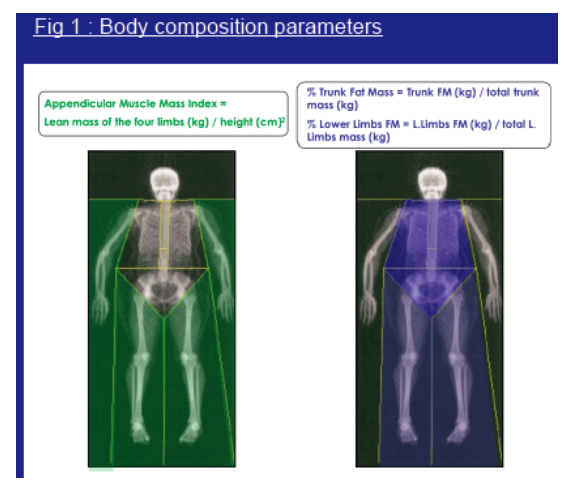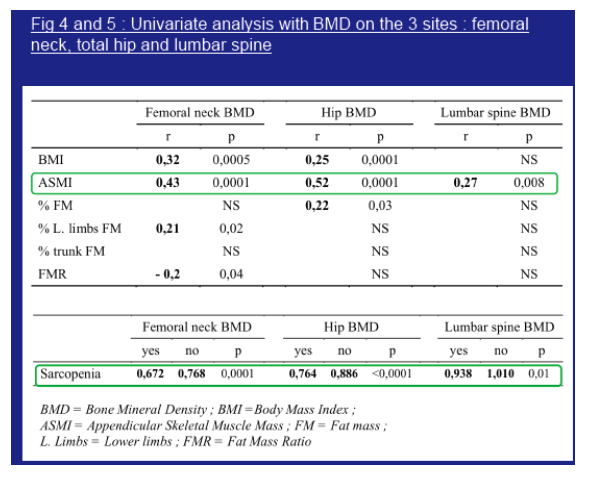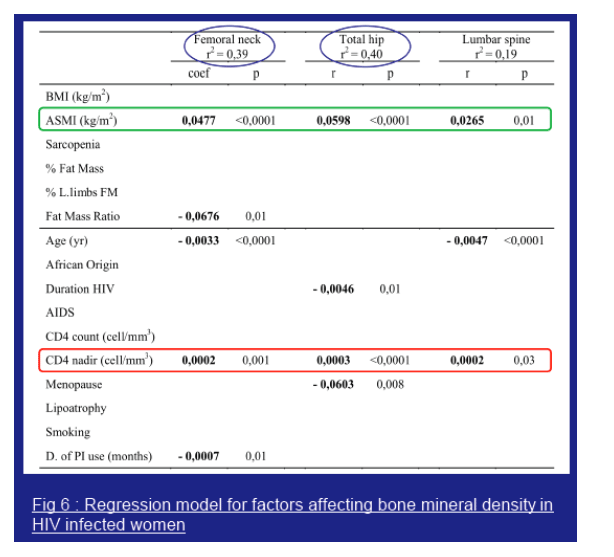 |
 |
 |
| |
Bone Mineral Density in HIV+ Women: Relationship to Body Composition
|
| |
| |
Reported by Jules Levin
CROI 2009 Feb 8-12 Montreal
Claire Lacoin*1, N Mehsen1, T Barnetche1, S Lawson-Ayayi2, C Cazanave1, T Schaeverbeke1, M Dupon1, D Lacoste3, J-L Pellegrin4, F Dabis2, and Groupe d'Epidemiologie Clinique du SIDA en Aquitaine
1Hopital Pellegrin, Bordeaux, France; 2universite Victor Segalen, Bordeaux, France; 3Hopital Saint-Andre, Bordeaux, France; and 4Hopital Haut-Leveque, Pessac, France
from Jules: actually, there have been previous reports associating lipoatrophy with bone loss, and this applies to men and women. But clearly this is an important point from this study, that muscle mass and strength loss and lipoatrophy lead to bone loss.
AUTHOR CONCLUSIONS
This is the first study reporting BMD association with ASMI (sarcopenia which is muscle mass and strength loss, discussed below) and adipose tissue repartition in a sample of HIV infected women. The correlation between ASMI and BMD is an argument for the development of anabolic strategies. Understanding the mechanisms leading to premature bone loss in HIV infected patients is important to set-up of preventive strategies and to develop anti-osteoporotic therapies appropriated to HIV infected patients.
ABSTRACT
Background: Osteoporosis is often observed in HIV-infected patients and the mechanisms leading to this premature bone loss are incompletely understood, especially for women. The aim of this study was to determine the correlation between bone mineral density (BMD) and body composition parameters in a sample of HIV infected women.
Methods: Femoral neck, total hip, lumbar spine (L2-L4) BMD and total and regional lean and fat mass were assessed by dual-energy X-ray absorptiometry. Several body composition parameters were calculated: percentage of body fat, percentage of the lower limbs fat mass, percentage of the trunk fat mass, fat mass ratio, which is the ratio of the percentage of the trunk fat mass to the percentage of the lower limbs fat mass, body mass index and appendicular skeletal muscle mass index, which is the ratio of the 4 limbs lean mass to the height squared. Correlations between each BMD site and body composition parameters were assessed by Spearman's test. A multivariate analysis by stepwise regression was also performed for each BMD site.
Results: We included in this study 125 HIV-infected women with a mean age of 43±10 years, of whom 25% were post-menopausal. Mean duration of HIV infection was 11.5±5 years. Mean T score was -0.93±1 at the femoral neck, -0.63±0.99 for the total hip, and -0.35±1.24 for the lumbar spine. According to the WHO OMS criteria, 8% of women were osteoporotic and 54% were osteopenic. Mean body mass index was 22±4.5 kg/m2, mean percentage of body fat was 28±8%, and mean appendicular skeletal muscle mass index was 6.3±1 kg/m2; 20% of the patients had sarcopenia (appendicular skeletal muscle mass index <5.45 kg/m2) and 32% had lipodystrophy. In the multivariate analysis, age negatively correlated with lumbar and femoral neck BMD, and menopause was associated with a lower hip BMD. Disease duration negatively correlated with total hip BMD. Duration of anti-protease therapy and fat mass ratio negatively correlated with femoral neck BMD. Appendicular skeletal muscle mass index and CD4 lymphocytes nadir were the main determinant of BMD as they correlated with lumbar, total hip and femoral neck BMD.
Conclusions: This is the first study reporting BMD association with appendicular skeletal muscle mass index and adipose tissue repartition in a sample of HIV-infected women. The correlation between appendicular skeletal muscle mass index and BMD is an argument for the development of anabolic strategies. Understanding the mechanisms leading to premature bone loss in HIV-infected patients is important to set-up of preventive strategies and to develop anti-osteoporotic therapies appropriated to HIV-infected patients.
BACKGROUND
Osteoporosis is highly observed in HIV infected patients and the mechanisms leading to this premature bone loss are incompletely understood especially for women. The aim of this study was to determine the correlation between bone mineral density (BMD) and body composition parameters in a sample of HIV infected women.

METHODS
Femoral neck, total hip, lumbar spine (L2-L4) BMD and total and regional lean and fat mass (FM) were assessed by dual-energy X-ray absorptiometry.
Several body composition parameters were calculated: percentage of body fat, percentage of the lower limbs FM, percentage of the trunk FM, fat mass ratio (FMR) which is the ratio of the percentage of the trunk FM to the percentage of the lower limbs FM, body mass index (BMI) and appendicular skeletal muscle mass index (ASMI) which is the ratio of the four limbs lean mass to the height squared (fig 1).
Correlations between each BMD site and body composition parameters were assessed by Spearman's correlation test. A multivariate analysis by stepwise regression was also performed for
each BMD site. A p-value threshold of 0,05 was decided.

RESULTS
125 HIV infected women were included in this study with a mean age of 43 ± 10 years.
A quarter of them were postmenopausal women.
Mean duration of HIV infection was 11,5 ± 5 years.
Mean CD4 lymphocytes level was 495 ± 280/mm3.
Mean T score was -0,93 ± 1 at the femoral neck, -0,63 ± 0,99 for the total hip and -0,35 ± 1,24 for the lumbar spine.
According to the OMS criteria, 8% of women were osteoporotic and 54% were osteopenic (fig 2).
Mean BMI was 22 ± 4,5 kg/m2, mean percentage of body fat was 28 ± 8% and mean ASMI was 6,3 ± 1 kg/m2.
20% of the patients had sarcopenia (ASMI < 5,45kg/m2), 32% of them had lipodystrophy. (see sarcopenia Definition and discussion below)
In a multivariate analysis, ASMI and CD4 lymphocytes nadir were the most associated factors of with BMD as they correlated with lumbar, total hip and femoral neck BMD. Age negatively correlated with lumbar and femoral neck BMD and menopause was associated with a lower hip BMD. Disease duration negatively correlated with total hip BMD. Duration of anti-proteases treatment and FMR negatively correlated with femoral neck BMD (fig 6).




From Jules:
Definition of Sarcopenia from http://en.wikipedia.org/wiki/Sarcopenia
Sarcopenia (from the Greek meaning "poverty of flesh") is the degenerative loss of skeletal muscle mass and strength associated with aging.
Sarcopenia is characterized first by a decrease in the size of the muscle, which causes weakness and frailty. However, this loss of muscle mass may be caused by different cellular mechanisms than those which cause muscle atrophy. For example, during sarcopenia, there is a replacement of muscle fibers with fat and an increase in fibrosis.
Exercise and increases in activity have been shown to be beneficial in settings of sarcopenia; exercise even in the very old can increase strength and muscle function.
Lack of exercise is currently thought to be a significant risk factor, increasing the likelihood of sarcopenia.[1]
Not only muscle but the entire musculoskeletal system of muscle, neuromuscular responsiveness, endocrine function, vasocapillary access, tendon, joint, ligament, and bone, depends on regular and lifelong exercise to maintain integrity. The slow attenuation, atrophy, or loss of muscle tissue that medical professionals sometimes describe as sarcopenia (literally, "flesh loss') is currently thought to be the result of cumulative loss of musculoskeletal strength and mass associated with chronic absence of exercise of sufficient intensity or volume.
Extreme muscle loss is often a result of both diminishing anabolic signals, such as growth hormone and testosterone, and promotion of catabolic signals, such as pro-inflammatory cytokines.
Strength losses with ageing for men and women are relatively similar. They are greater for lower than upper extremity muscles. Maximum attainable strength peaks in mid-twenties and declines thereafter. The decline is precipitous after 65 years of age, though few longitudinal studies exist on this topic. A direct assessment of the effects of sarcopenia, even in extremely physically fit individuals, can be seen in the age-related decline in Masters athletics (track and field) world records of muscle-intensive sports, such as weight lifting. No substance-free proven Olympic weight lifting record has been set by any athlete of any sex or weight class above the age of 31. However, in the sport of powerlifting, many world records in several weight divisions have been accomplished by athletes well into their forties. It has been postulated that while Olympic weightlifting requires great speed to accomplish the snatch and clean and jerk movements, the squat, bench press and deadlift require no such attribute and only great limit strength is required. These world records are verified by the International Powerlifting Federation, and are certified by that organization to have been accomplished drug-free.
Making the clinical diagnosis of sarcopenia is difficult for the following reasons. There is no absolute level of lean mass, body cell mass, or muscle mass for comparison. There is no generally accepted clinical test to diagnose sarcopenia. Finally, there is no accepted threshold of functional decline at which sarcopenia is implied. However, the use of whole-body dual-energy x-ray absorptiometry (DEXA) or CT scans of the abdomen to assess muscle mass is being assessed in research settings. Baumgartner et al. published a working definition of sarcopenia based on 2 standard deviations below the mean for healthy young adults which has been used in research settings.[2]
Management
Primary management of sarcopenia is through the application of a graded exercise program, across both cardiovascular and strength domains, dosed in such a way as to provoke beneficial adaptation without overloading the weakened body.[3] Possible therapeutic strategies include resistance training and aerobic activity programs, as evidenced by recent studies. Nutritional evaluation may also be indicated if malnutrition is suspected, or current nutritional intake is insufficient to maintain adequate total body mass, although increased exercise also increases appetite. Physical activity incorporating resistance training is probably the most effective measure to prevent and treat sarcopenia.
|
| |
|
 |
 |
|
|